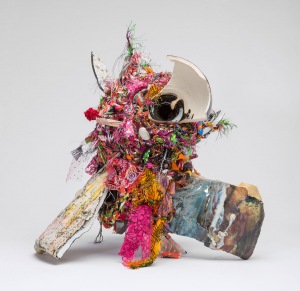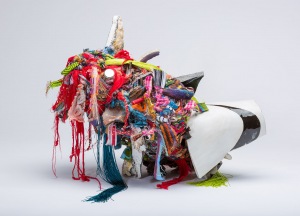Brian Boucher’s Daily Dispatch | San Francisco, January 17, 2020
UNTITLED, ART.

If you’re looking for the works that pack the most coloristic punch in a small package at the current edition of UNTITLED, ART in San Francisco, you could do worse than to spend some time with San Francisco artist Ramekon O’Arwisters, at San Francisco dealer Patricia Sweetow’s booth. And not only that — you might also find that they are packed with heart, generosity, and vulnerability, much more than the average work you’ll find on an art fair’s sales floor. The artist spent some time at the VIP preview, where a steady stream of fans came through; he’ll continue to hang around for the rest of the fair, too.
The works, which stand no more than about three feet high, are made of just two materials: ceramic shards and fabric. In a collaboration with ceramic artist Tony Marsh and his fellow instructors and his students in the ceramics studio at the University of Southern California Long Beach, O’Arwisters collects the refuse from their projects, including small and large pieces sporting varied colors and surfaces, and uses multicolored fabric from torn-up designer garments to tie them together; he finds the latter at Mood designer fabric wholesalers. “It’s where RuPaul’s Drag Race contestants shop for fabrics,” he told me. The results are a visual riot of color, shape, and surface. Their seductive nature is winkingly summed up in the name of the series: the artist calls them “Cheesecake.” They sell for prices ranging from $5,800 to $15,000.
The artist is also known for events he calls Crochet Jams, in which anyone in attendance gets to create their own masterworks using the titular technique. His participatory work involving textiles grows partly from his childhood experience creating quilts with his grandmother. It also draws partly on his experience earning a master’s degree in divinity from Duke University, where he was fascinated with the notion of transubstantiation, in which wine and Communion wafers are miraculously transformed into the body and blood of Christ.
Born in North Carolina, O’Arwisters studied divinity at Duke University before becoming an artist. He’s been artist-in-residence at San Francisco’s de Young Museum, at the Djerassi Resident Artists Program in Woodside, California, and at the Vermont Studio Center. He’s won grants, fellowships and awards from Artadia, the San Francisco Arts Commission Cultural Equity Program, and the Fleishhacker Foundation, in San Francisco. Writers from publications like the Los Angeles Times and the San Francisco Chronicle, among others, have highlighted his work.
I spoke with the artist about the meanings of his Cheesecake sculptures, his atypical academic background, and about finding his own way in the art world.
How exactly does your collaboration with Marsh and his colleagues and students work?
They give me their shards, their discarded pieces, and I donate to their scholarship fund, so it’s mutually beneficial. Instead of using domestic ceramics, I like the idea of using one-of-a-kind shards. People haven’t seen these designer fabrics or broken ceramics or crocheting or quilting in this context. The idea is, how do you create something no one has seen?
We all feel broken sometimes. There’s a symbolic nature to a vessel, because we too are vessels. We hold blood and tissue and emotions. I also like the idea of putting it in a dream language. We don’t want to be fixed but just … put together. Don’t throw me away, just Frankenstein me!
I don’t think I talk to too many people in the art world who earned a master’s degree in divinity. How have the things you learned there continued through your work?
In studying the early church, you get exposed to the miracle of transubstantiation. So I take just two everyday materials and commune with them in such a way that they reveal their secrets. They trust me that much that, while they still are fabric and ceramics, it feels like another material, like marble or steel. That’s one of the most profound things I’ve taken from my studies in seminary. We are the power, and we can transform things, as long as we trust the material enough to allow it to become what it wants to be. You’re just the conduit for that transformation.
Were you seeing transubstantiation as an artistic concept at that time, in seminary, or did that connection come later?
The connection came much later. It stuck with me because of, one, the history of it. The church had a problem. They thought, “We sound like we’re carnivores, chewing on the body of Christ!” But there must have been some bishops’ council where they came up with the notion of transubstantiation, the whole idea of being able to change but still look like the same material. When the priest gives Communion, the miracle happens once the words are said. That seems magical.
It’s easy to see an echo of the Japanese phenomenon of kintsugi, in which broken pottery is repaired with precious materials. Is that something you think about as a conceptual kin to your work, or are there other precedents you feel more attached to?
I lived in Japan for five years. I must have somehow gotten that idea that these broken objects are made more beautiful by the scar that is left, and it’s even more valuable because we care about it enough that we want to repair it. I have a difficult time separating the atoms that make who I am, and the atoms that make other things. Wouldn’t it be great if we could treat other people that way? We’re going to mend you and make you even better than before you broke! I would go see these pieces and just stare at them. It seemed supernatural. They’re putting things as they were. I like the idea of letting things transform in front of me.
Many artists working with textiles have been experiencing new attention in recent years, like Sheila Hicks, Faith Ringgold, and then, not too far from you geographically, Judith Scott. What do you think about this turn of events? What’s that like for a person who works with fabric a lot?
We decide what art is. For me the whole idea is not waiting for people to decide that what you’re doing is important. That’s not a path I’m gonna follow anymore. I’m happy this new interest in fabric art is here but the materials that best represent my worldview and my experience is broken ceramics and fabric.
My mother made quilts, and made our clothes. I wish I still had those clothes. I do have my grandmother’s and my great-grandmother’s quilts. My father worked in a textile mill. My mother worked in a textile mill. We’re all wearing textiles. You are too! We’re not walking around wearing oil paint on canvas! For the longest time I thought I wasn’t an artist unless I was working in oil paint, but no one in my family uses oil paint to express their world view, their pain, their joy. I stopped trying to fit myself into a straight while male paradigm. I’m black and I’m queer. So then I had the realization, why not use fabric as your material? It doesn’t matter whether people like it or not.
And broken ceramics. How do I help people understand their own unhappiness and pain, help them navigate their own feelings? Broken ceramics is for me the best material to help people understand what it feels like to be black and queer in America. You feel sharp and broken. You feel detached and thrown away. When people see these pieces, I hope what they see is a reflection: “I feel broken.” Maybe not consciously, but I’m not worried what people think about consciously. I’m only going to the unconscious. I want them speaking to me in a primal language. Grunts! Moans! Oohs! Aahs! Bare bones! And I want them to be able to relate to the work. How do I help people connect to themselves?
So, to answer your question, I’m happy this transition is here, but my thing is to trust my creativity, because honestly, it’s the only thing that I really can trust. If the art world is accepting it, great. If they’re not, great.
Do these ideas about love and unity, separation and reconciliation, go back to your divinity training also?
Some of it may go back to divinity, but more of it is about spirituality and how I defined it. I started out in the church and I moved from there to Tai Chi and then to Vipassana meditation. The church was always telling you what to think. It was dogma. I grew up in a church where there was a blond Jesus on the cross and everybody in the church was black and brown. Whereas in meditation, this is your own experience from the inside out. You just have to breathe and feel your emotions.Your feelings and sensation are your truth. When it comes to love and compassion, that’s not come so much out of the church. The church has a lot of history that hasn’t been focusing on love and compassion and forgiveness and understanding. Isn’t that incongruent to the teaching of Christ?

When I looked at your works in photographs, I found that you can see a few different views of a single object but not even realize you’re looking at the same piece. You get an incredible variety of shapes and profiles in the same sculpture. How does that come about?
A lot of it comes about because I grew up quilting with my grandmother. African American quilts are African American quilts because of contrasting colors and improvising with the materials and patterns. I grew up in an atmosphere where you could improvise! You don’t worry about how it looks. With traditional quilts, they have to be cut a certain way, and you follow a pattern. I grew up in the Jim Crow South. There wasn’t a pattern that we could follow. Jazz is about stepping out of the pattern. You find the rhythm somewhere else. I’m taking materials out of one context and putting them into a fine art context as opposed to a folk art tradition, and then taking something that’s broken, so it has its own symbolic meaning. For me that’s creativity and innovation. This helps me to create something no one has seen.
UNTITLED, ART.
WRITTEN BY Brian Boucher
UNTITLED, ART is an international, curated art fair founded in 2012 that focuses on balance and integrity across all disciplines of contemporary art.
